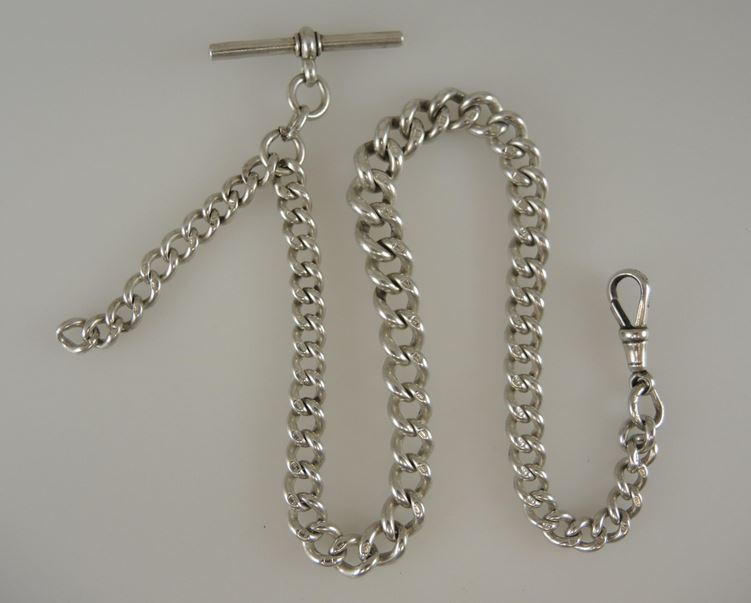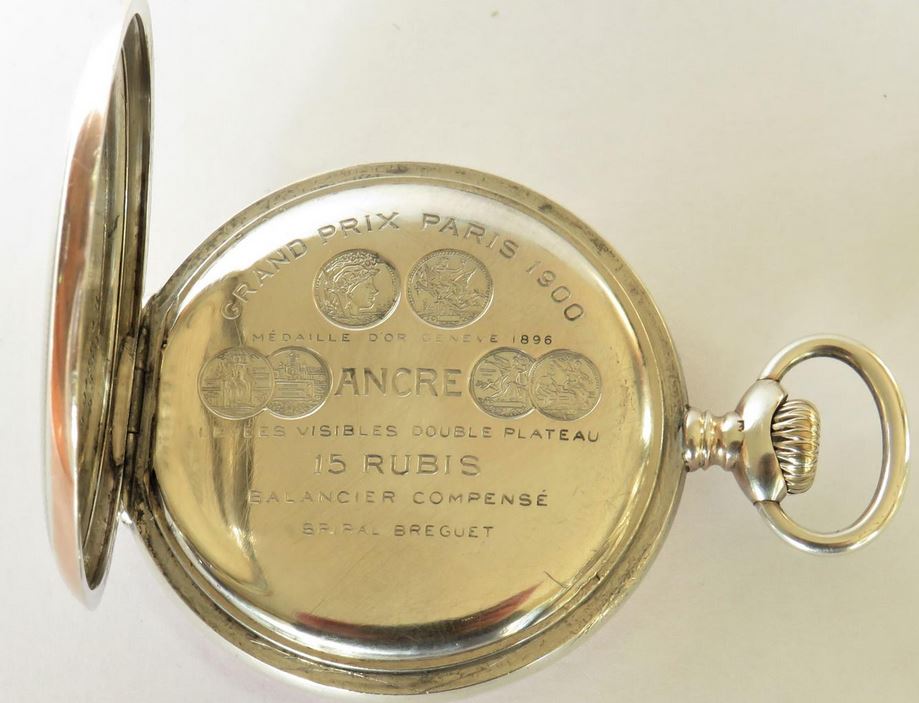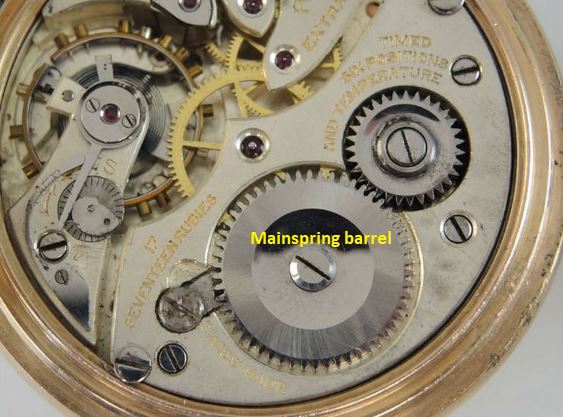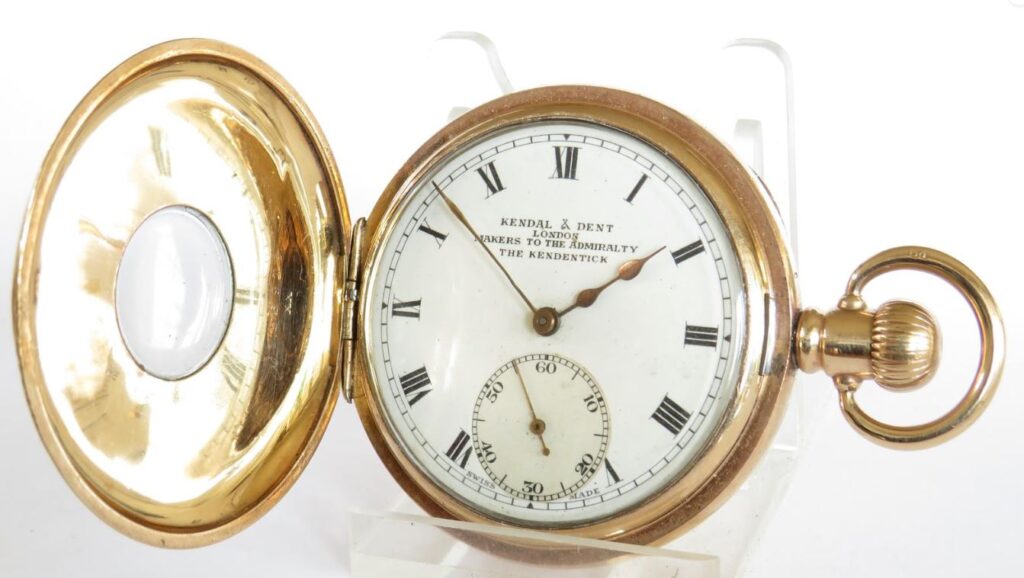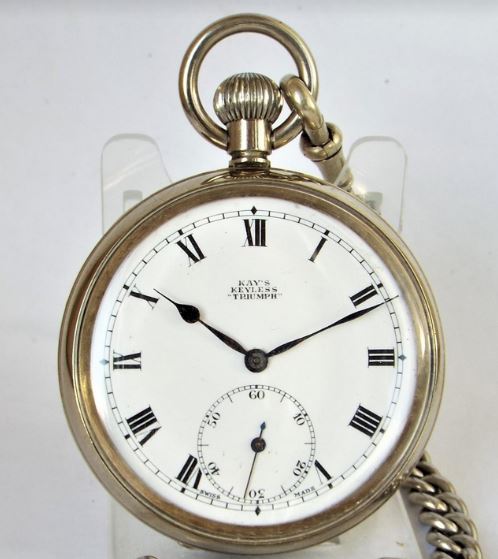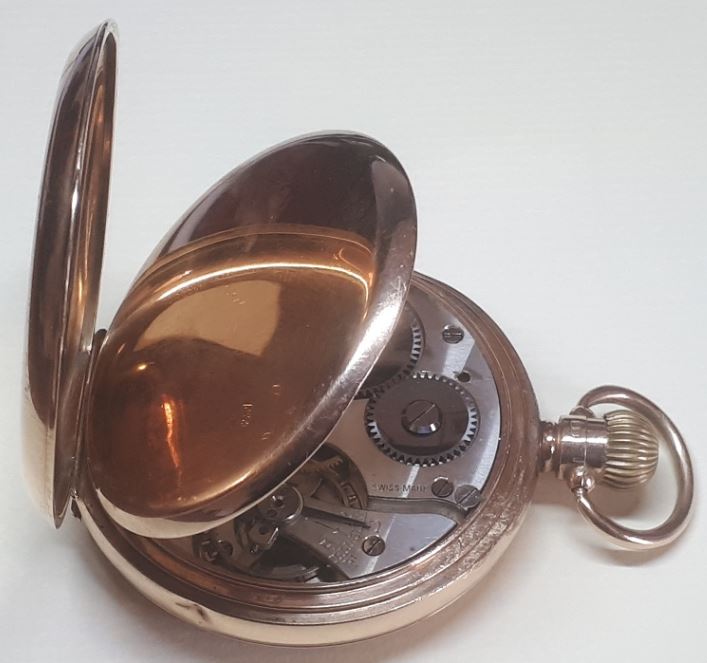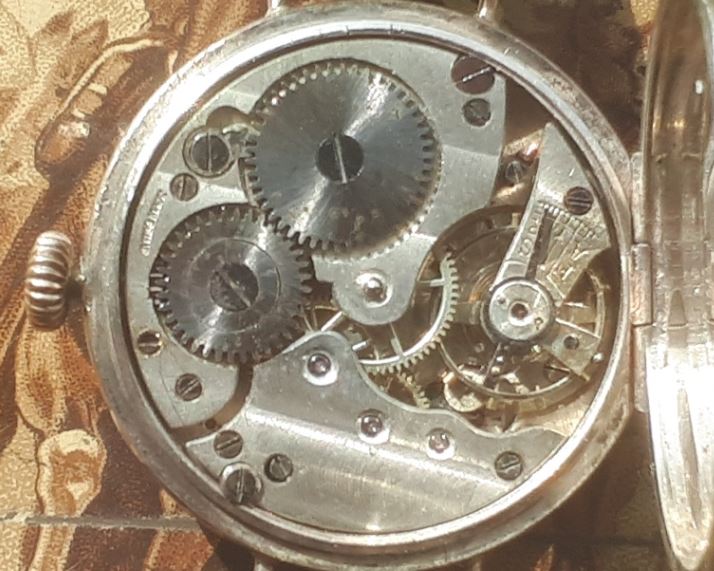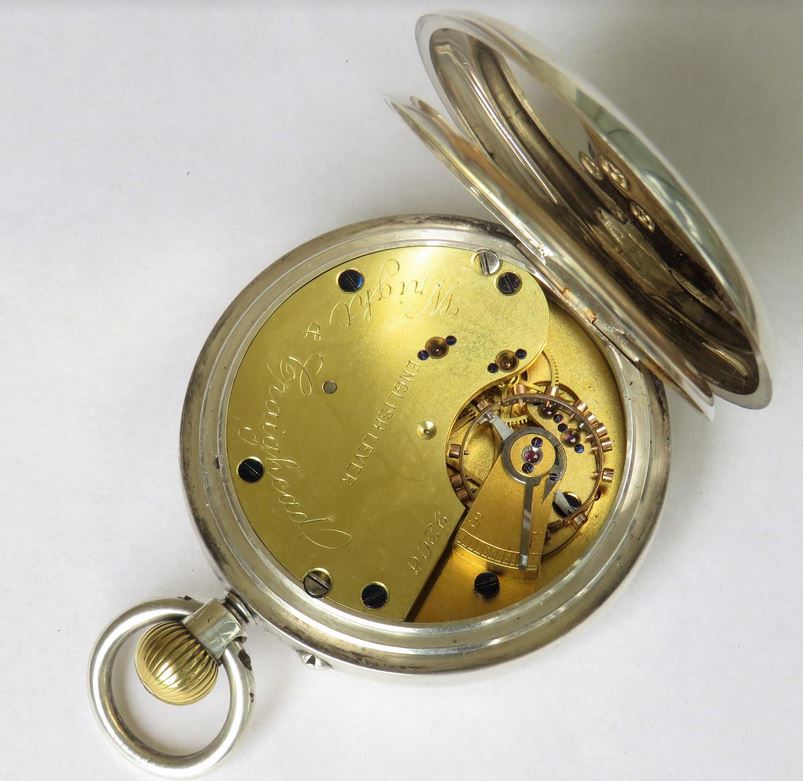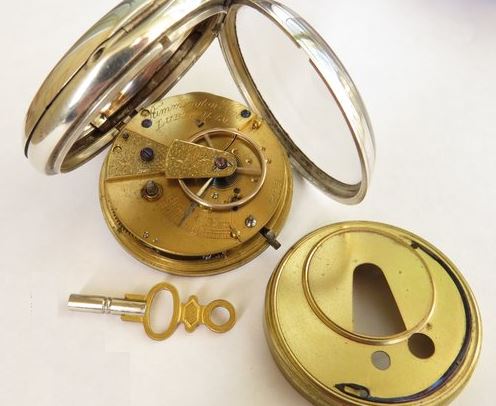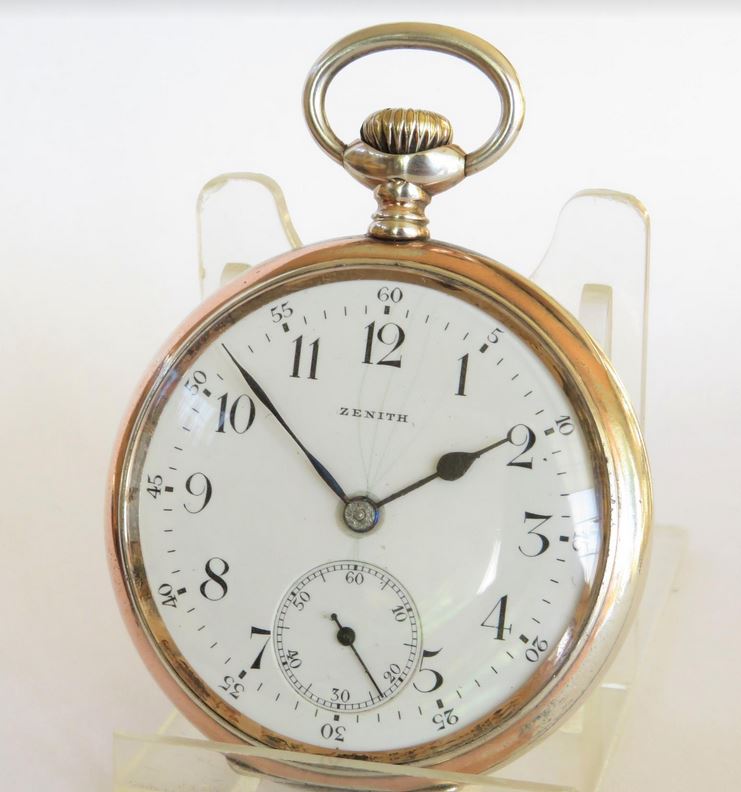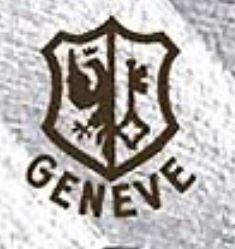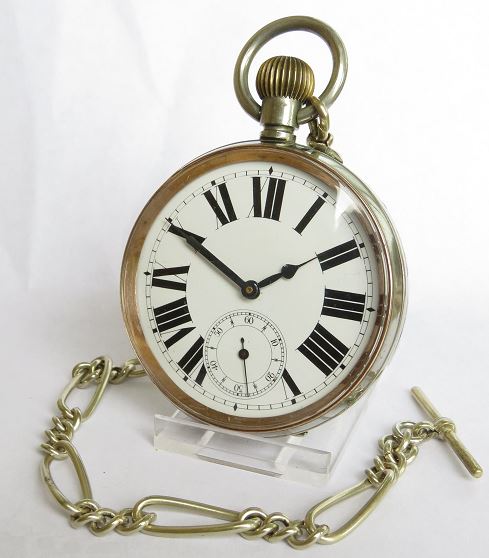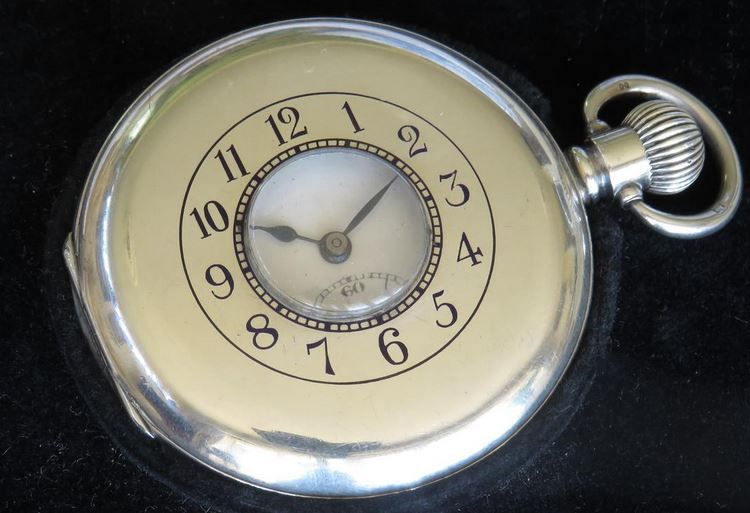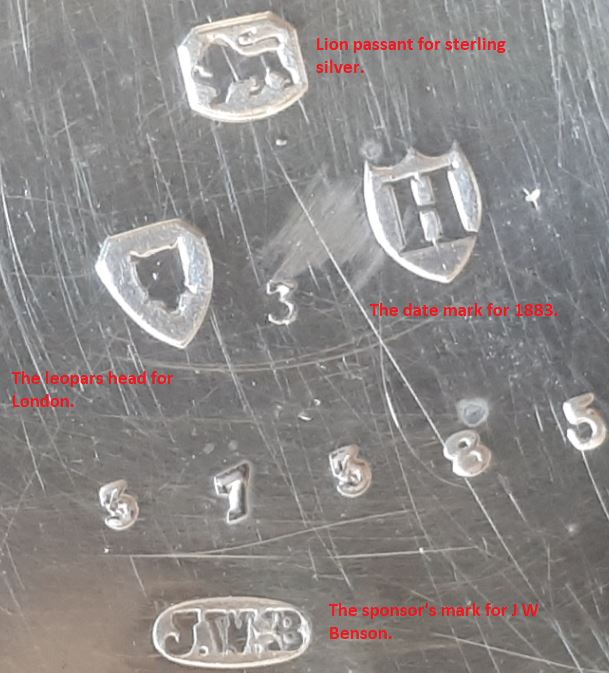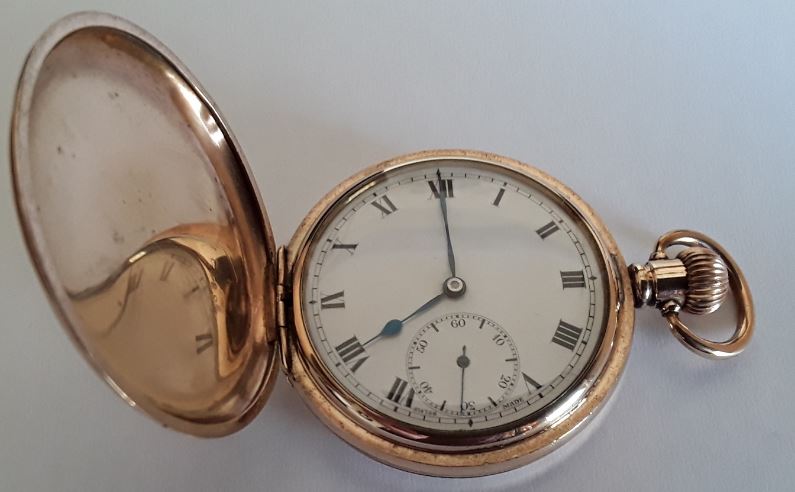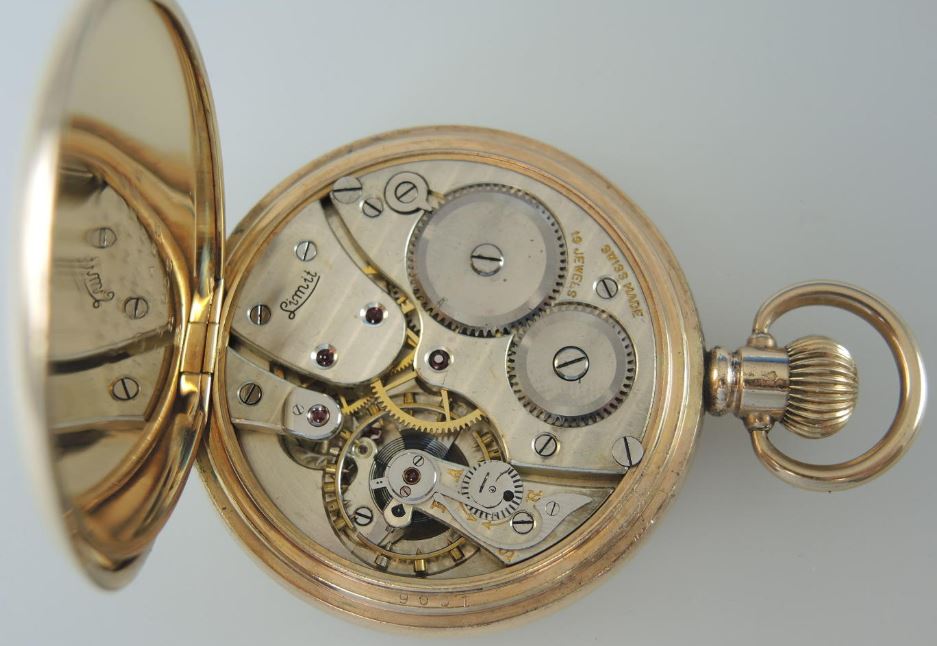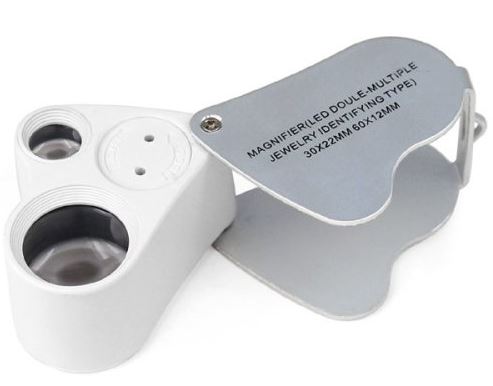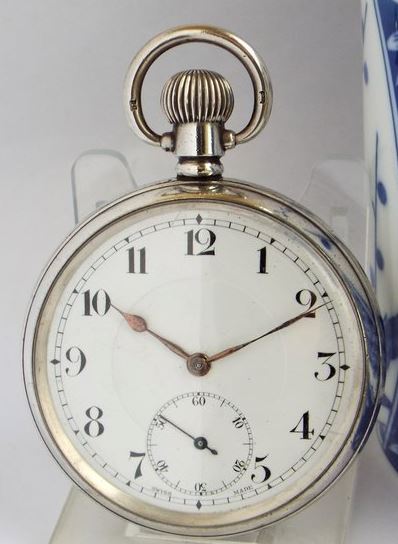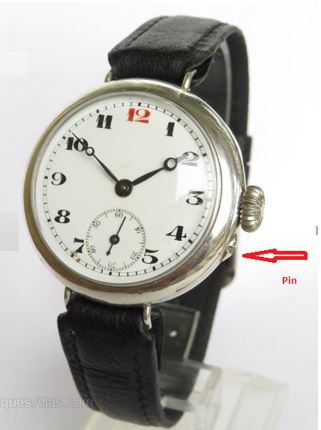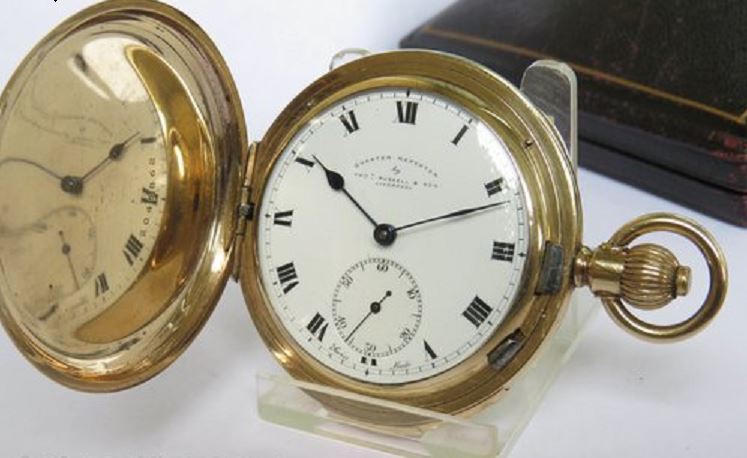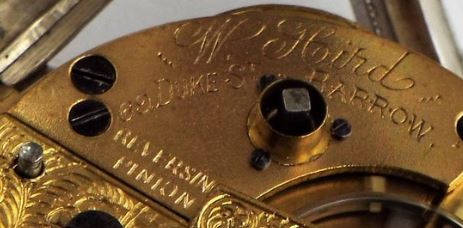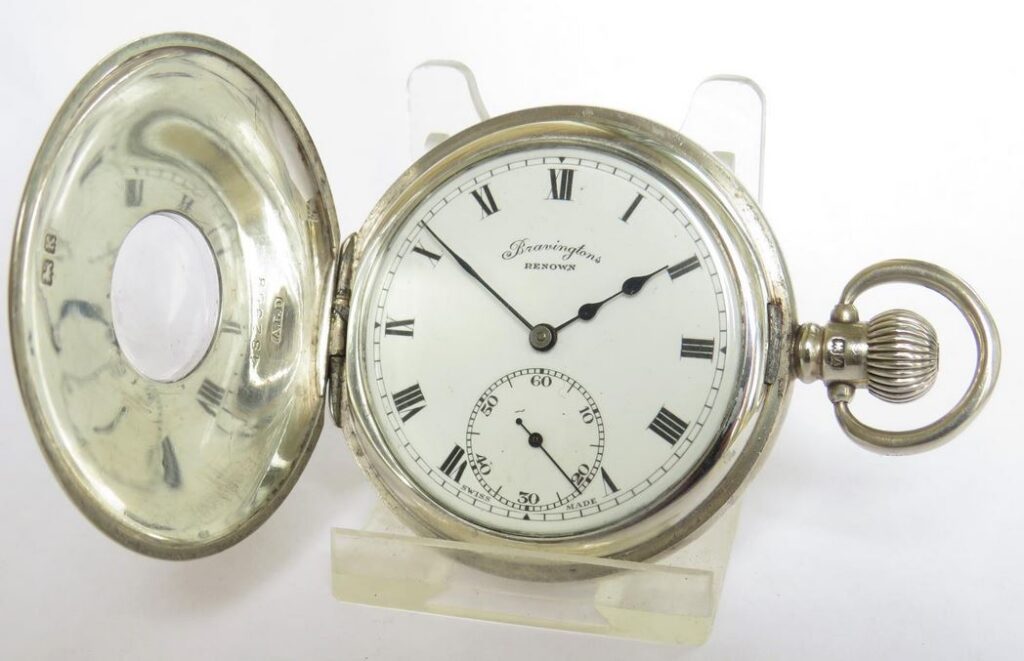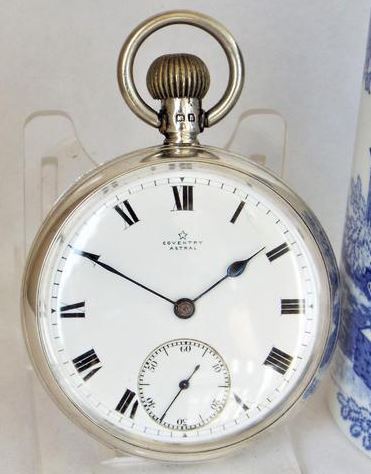Even the simplest of antique watches can contain over a hundred parts. Each component has a critical part to play in the timekeeping process. The key components are described in the antique watch glossary below.
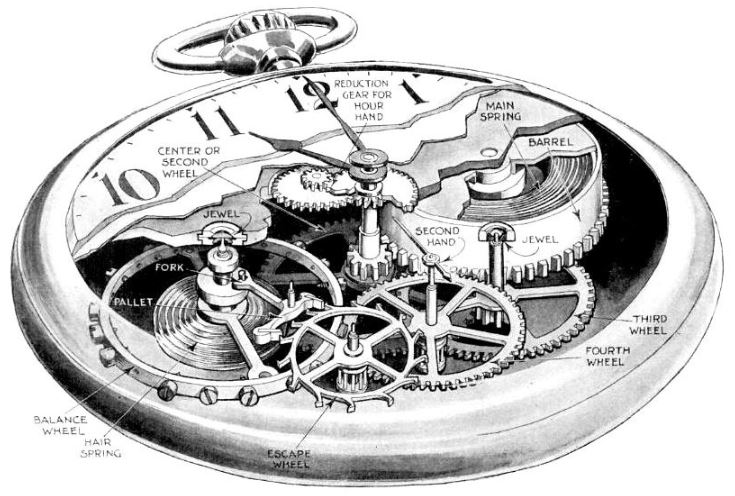
Albert
An Albert is a chain attached to a pocket watch that secures it to a waistcoat button-hole or lapel button-hole with a T-bar. A Double Albert has two chains extending from the T-bar. The pocket watch goes on one end of the chain and sits in the left-hand waistcoat pocket. The other end of the chain will hold a fob, a winding key or a cigar cutter and will be placed in the right-hand waistcoat pocket. The Albert is presumed to be named after Prince Albert, the husband of Queen Victoria. The Albert was typically worn by Victorian gentlemen. The Albertina is the ladies’ version, which tends to be finer and more decorative (Albert chains at Wikipedia).
Ancre
Ancre is a French word that translates to anchor and indicates that the watch movement is equipped with a lever escapement.
Arbor
An axle that holds, turns or supports a rotating component of the movement, such as the barrel.
Assortment
In watchmaking, an assortment is a set of parts that form a single part of a watch. Generally, the term assortment is used to describe the timekeeping components of the movement, including the escape wheel, balance wheel, hairspring, anchor lever, pallet stones, and associated bridges.
Balance Staff
The balance staff is the centre shaft or axle on the balance wheel. Each end has a “pivot”, which is a very thin point that the balance wheel rides on. The pivots are supported by the balance jewels.
Balance Wheel
The balance is a weighted wheel that rotates back and forth, being returned toward its centre position by the balance spring. It is driven by the escapement, which transforms the rotating motion of the watch gear train into impulses delivered to the balance wheel.
Barrel
A barrel is a cylindrical metal box closed by a cover, surrounded by a ring of geared teeth. It contains a spiral spring called the mainspring, which provides power to run the timepiece.
Bezel
The bezel is a part of the watch’s outer case. It is not considered part of the movement. It is the metal “frame” that holds the crystal in place on the watch. On a pocket watch, the bezel is almost always circular, but on wristwatches, the bezel can be almost any shape. Most open-face pocket watches have screw-on or hinged bezels, while most hunter-case pocket watches have “snap-on” bezels.
Blued steel
Bluing steel is a process that tempers the steel and creates a protective oxidised coating that helps to prevent watch hands from rusting. First, the steel hands are cleaned and polished. Next, the hands are heated, over a bed of brass filings, to a high temperature. The layer of brass filings is used to maintain a stable temperature exchange. The steel changes colour from gold to brown and then purple before it settles to blue (Blue steel at wikiHow).
Bow
The loop at the top of the stem over the crown, which is used to clip an Albert chain to the watch. The bow is considered to be part of the case, not the movement.
Bridge
A complementary part fixed to the main plate to form the frame of a watch movement. A bridge spans across an area of the movement and is attached to the movement plate at both ends.
Case
The case is the metal housing that contains the movement of the watch. The case can be made from almost any type of metal. Many antique pocket watch cases are brass or base-metal plated with gold. The case comes in two main types of design, open-face and hunter.
Chapter Ring
The chapter ring is the outer part of the dial that marks the hours and the minutes.
Chronometer
A chronometer is a specific type of mechanical timepiece tested and certified to meet certain precision standards. A marine chronometer is used for celestial navigation and the determination of longitude. The first practical marine chronometer was invented by John Harrison in 1730. This was the first of a series of chronometers that enabled accurate marine navigation. A demi or half chronometer in a timepiece made to chronometer standards, but has not been formally certified or failed certification.
Collet
A collet (collar) is a metal band used to hold the end of the hairspring to the balance staff.
Compensated balance
A balance that has been constructed to offset the effects of temperature changes. A compensated balance is typically made using strips of two different types of metal, which expand or contract at different rates due to changes in temperature. A compensated balance significantly improves the accuracy of a watch (Compensation Balance at Hodinkee).
Complication
A complication refers to any feature in a mechanical watch beyond the display of hours, minutes and seconds. Examples include repeaters, chronographs, automatons and date functions.
Crown
The knob at the end of the stem is used for winding the watch and setting the time.
Crystal
The glass piece that covers and protects the dial and hands. The crystal can be made from glass, sapphire or acrylic crystal.
Cuvette
The cuvette is a second cover inside the case back of an antique pocket watch, which provides additional protection for the mechanism or as a dust cover. Many pocket watch cases can be opened to reveal an inner cover, known as a “cuvette” (French for “bowl”), which itself can be opened to access the movement. This design dates back to key-wound pocket watches, which were often wound and sometimes set from the back. The back cover was opened each time the watch needed winding or time-setting. A key with a hollow, square end was then placed over the square fitting on either the mainspring barrel arbor (for winding) or the setting arbor (for adjusting the time). Turning the key on the mainspring barrel arbor would wind the watch, while turning it on the setting arbor would move the hands to set the time. Without a protective inner cover, there was a risk that a slip of the key could accidentally press into the delicate mechanism, potentially causing damage. The cuvette may be engraved with inscriptions or the maker’s branding. In English, it is called the dust cover, which was its secondary purpose. Later keyless watches continued to use the cuvette or dust cover.
Dial
The “face” of the watch. The dial is most commonly made of metal or glass-like vitreous enamel on a metal base. The dial is usually marked with numbers (or indices, batons & bars) to divide the 360 degrees into hours and minutes, sub-dials showing additional information are called registers.
Double roller
A movement with a double roller is more robust than one with a single roller. A double roller has a safety feature consisting of a guard pin positioned to engage a smaller roller located below the primary roller table. This arrangement locks the lever in place until the impulse jewel returns to the pallet fork. A single roller doesn’t include this feature, and the lever could be moved out of position by a sudden jolt, stopping the movement. A double roller is known as a double plateau in French.
Ebauche
An ebauche is a basic or blank movement often purchased by a watchmaker from an external manufacturer and then modified and branded. The process of completing the watch is known as finishing (Ebauche movement at Watch Wiki).
Escapement
The escapement is the component of the movement that allows the power of the mainspring to be regulated. It allows the power to “escape” slowly and in a regulated fashion, thus keeping time. The lever escapement, invented by British clockmaker Thomas Mudge in 1755, is the type of escapement that is used in almost all mechanical watches.
Fob
These days the terms fob watch and pocket watch are used interchangeably. However, there are actually several definitions for the term fob. Apparently, the name originates from the low German (Prussian) dialect word ‘fuppe’, meaning small pocket. Try as I may I have not been able to find an online translator to confirm this theory.
The definitions of a fob are:
A small pocket for carrying a watch, as per our unconfirmed German translation.
Also, a short chain or strap to a watch for carrying in a waistcoat or waistband pocket. This is similar to what is seen on modern fob watches for nurses. This is a somewhat shorter chain or strap than the traditional Albert watch chain.
Lastly, a fob is a small ornament or token attached to a watch chain. This could be a practical piece, such as a cigar cutter, penknife or seal. It could also be simply a decorative piece, such as a medallion with the owner’s initials engraved.
It is from these three definitions that the pocket watch acquired the name fob watch by association. My preferred definition is the latter. These fobs were popular during Victorian times. The fobs would be attached to an Albert chain via a short length of chain called a drop. Similar to key chains, watch fobs came in a variety of types, each with its own style and function. Fobs could be decorative and functional at the same time.
Fusee
A device intended to reduce the effects of uneven power as the mainspring winds down. The mainspring barrel is connected to the fusee, a conical intermediate wheel, with a tiny chain. The fusee is connected to the gear train. When the mainspring is fully wound, most of the chain is wound around the fusee all the way to the narrow end of the cone. As the watch runs, the chain unwinds down to the wide end of the fusee cone as the chain wraps around the mainspring barrel. This has the effect of equalising the power transmitted to the gear train because the lever arm of the chain pulling the fusee is shorter when the mainspring is fully wound, and longer when the mainspring is unwound (What is a “Fusee” pocket watch? at the Watch Museum).
Galonne
Galonne is a style of pocket watch case, which was popular in the early 1900s. It is a French term for gold-plated silver.
Gear Train / Wheel Train
The gear train is the interconnected system of gears and pinions which transmits power from the mainspring to the escapement.
Geneva seal
The Geneva seal, also called, the Poinçon de Genève is a watch quality seal of the Geneva testing office “Bureau Officiel de l’Etat pour le contrôle facultatif des montres de Genève”. The seal has been awarded since November 6, 1886. To earn the Geneva Seal, a watch must be assembled, regulated, and cased in the canton of Geneva, and must meet a number of stringent requirements regarding the movement, mechanism, and finishing.
Glass
An alternative name for the crystal. The crystal can be made from glass, sapphire or acrylic crystal.
Going barrel
This is the arrangement of the mainspring barrel so that the barrel arbor is turned to wind the watch, and the barrel itself turns as the spring unwinds. The power is transferred to the gear-train by the engagement of the teeth on the barrel rim and the pinion of the centre wheel. This arrangement means there is always tension on the mainspring, even during winding, so the gear train keeps “going”.
Goliath pocket watch
Goliath pocket watches, as the name suggests, are considerably larger than normal. A typical men’s pocket watch is around 50 mm in diameter. The term Goliath tends to be applied to those pocket watches with a diameter of 60mm or more. The larger size would allow for a larger mainspring and therefore a longer power reserve.
Guilloche
A repetitive decorative engraving technique used on dials and cases.
Gunmetal
Gunmetal is an alloy formed of copper, tin and zinc. Originally, it was used, as the name suggests, for making guns. It is highly resistant to corrosion from steam and water. It has a dark, mottled appearance. However, with respect to watch cases, the use of the word gunmetal is a little confusing. This is because gunmetal watch cases are actually made of steel that has been treated with caustic soda. This procedure involves submerging the steel case parts in a caustic solution at a high temperature. This gives the steel resistance to corrosion and the appearance of gunmetal. In reality, the cases should be described as steel with a gunmetal finish (Gunmetal at Vintage Watchstraps).
Hairspring
The delicate, spiral-wound spring which governs the oscillation of the balance wheel and provides the fundamental timekeeping mechanism of the watch. The Hairspring performs the same role as a pendulum in a clock.
Half Hunter (Demi-Hunter) Case
A hunter-case pocket watch with a circular window cut in the lid covering the dial, which allows the time to be read through the window, without opening the watch. The lid often has the hours engraved or pressed into the metal to make reading the time easier.
Hallmark
An item made of precious metal that is to be sold commercially is stamped with hallmarks to indicate the purity of the metal. Additional markings can include the manufacturer’s logo, serial numbers and assay office. There are British and Swiss hallmarks referred to on this website (What is a hallmark? at the London Assay Office).
Horology
The study of the measurement of time, which includes clocks and antique watches.
Hunter Case
A watch with a front cover or sprung lid to protect the crystal and dial. The lid is usually sprung and released by pressing the crown on the stem.
Isochronism
Isochronism is derived from Greek roots (iso & chronos) and means, literally, “in the same time.”. A pocket watch is a machine for counting the swings of an oscillator. If the oscillation is not consistent then it is impossible to keep accurate time. Therefore, a watch must be isochronous in order to be accurate.
Jewels
A tiny “bearing” that supports (or caps) a wheel pivot to reduce friction, or is otherwise used to reduce friction and provide a smooth, hard bearing surface within the mechanism of the watch. Usually made of synthetic ruby or synthetic sapphire. In general, the higher the jewel count, the higher the grade of the watch. A 15-jewel watch is considered “fully jewelled”. 19-jewel or higher is considered a high-grade watch. The jewels themselves have no value as precious stones (Types of jewels at SwissWatchExpo).
Lépine
A Lépine calibre is intended for use in open-face pocket watches with the pendant and crown at 12 o’clock and small seconds at six o’clock. It was invented by the French watchmaker, Jean-Antoine Lépine in 1764/65 and it allowed for the construction of thinner watches.
Lever set
A watch that is set by moving a small lever, which is usually located under the bezel. This is a safety feature of railroad pocket watches that prevents accidental changes to the time.
Ligne
A ligne is a traditional measurement of length used by Swiss watchmakers to describe the size of the movement. A ligne (pronounced lines) is 1/12 of an old French inch, which is about 2.256mm. It wasn’t used as a precise measurement as typically, manufacturers would round up or down to the nearest half ligne. For example, a 42mm movement would be rounded up from 18.5 to 19 lignes.
Loupe
A loupe, pronounced LOOP, is a small magnification device used by watchmakers to examine the minute components of a watch’s movement.
Lugs
Extensions on the sides of a wristwatch case where the bracelet or strap is attached.
Mainspring & Mainspring Barrel
The wound, flat metal spring which provides the motive power for the watch. Older mainsprings were “blue steel,” but more modern mainsprings tend to be made of alloys that are more resistant to breakage and corrosion.
Marriage Watch
A marriage watch is a term used to refer to the union (or marriage) of a modern case with an antique watch movement, usually antique pocket watch movements. In essence, it is a pocket watch converted into a wristwatch, combining an antique movement with other original parts and/or non-original parts.
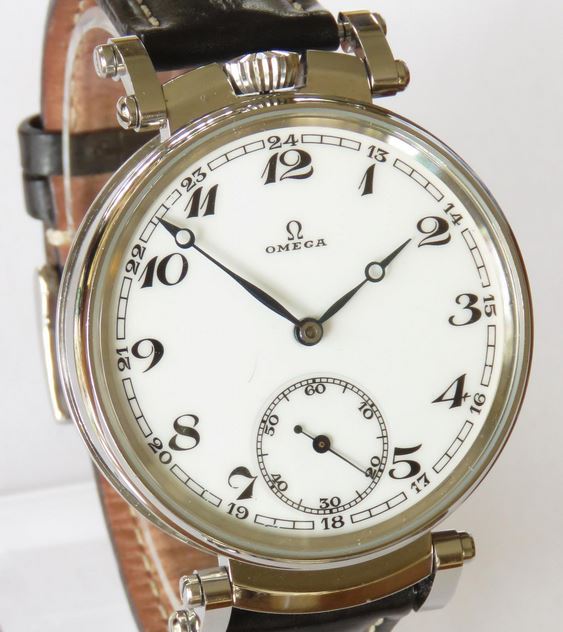
Mechanical Movement
A movement based on a mainspring which, when wound slowly, unwinds the spring in an even motion to provide accurate timekeeping. Many movements are purchased as “Ebauche” by watchmakers and then refined (Types of watch movements at Wikipedia).
Mineral Crystal
The glass transparent covering (crystal) of the watch dial. It can be glass, sapphire or acrylic.
Nickel Silver
A composition of nickel, copper and zinc, often used in vintage watch cases. It contains no silver. Also known as German Silver.
Open Dial
A pocket watch with no lid or metal cover for the crystal and dial.
Patina
A thin surface layer that develops on material, such as metal or leather, due to age and usage. Patina is normally considered desirable to collectors, but should not be confused with damage (Why vintage watch collectors go mad for patination at Mr Porter).
Pinion
The geared arbor of a wheel, which is “pushed” by a larger wheel.
Pin-set
A pin-set movement has a pin that needs to be depressed to set the time. It is a safety feature similar to the lever-set movement for pocket watches.
Power Reserve
The power reserve is the amount of time the watch can run after being fully wound.
Register
A sub-dial on the main dial, usually showing the seconds, but can show other complications such as the date or moon phase.
Regulator
Part of the balance mechanism used to make fine timekeeping adjustments. The regulator usually has 2 vertical pins which straddle the hairspring and can be adjusted to make the effective length of the spring longer or shorter, resulting in changes to the rate of the watch. Typically, the regulator will be marked “Fast” and “Slow”, or “Advance” and “Retard” (Pocket watch regulators at the Pocket Watch Database).
Repeater
A watch with a striking complication that chimes the hours and quarters.
Reversing pinion
A reversing pinion is an invention designed to prevent damage to the movement in the event of a mainspring breakage. Instead of the centre wheel pinion being fixed to the staff, it is screwed on. In normal use, the gear teeth on the mainspring barrel bear against the pinion and keep it screwed down. If the pressure is suddenly reversed, the pinion unscrews and the power dissipates harmlessly without passing through the gear train.
Sapphire Crystal
A very hard and transparent synthetic form of sapphire, which is used as a watch glass or crystal. Sapphire is highly scratch-resistant with a value of 9 on the Mohs scale of mineral hardness. As a comparison, a diamond has a value of 10.
Savonnette
A savonnette is a French term for the configuration of the type of movement used in hunter cased watches. This is where the lid-hinge is at the 9 o’clock position and the stem of the watch is at the 3 o’clock position. The sub-seconds dial is at the 6 o’clock position as per the open-faced pocket watch. The same configuration is used for wristwatches.
Sidewinder
This is a pocket watch where the stem emerges from the watch at 3:00 rather than at 12:00. This is most common with hunter cases because it makes the time easier to read when you open a hunter, as you hold it in your right hand and press the stem with your thumb to open the lid. 12:00 ends up naturally in the correct position at the top of the dial. A watch re-cased from a hunter case to an open-face case is known as a sidewinder.
Stem
The shaft that sticks out of your pocket watch with the crown on the top, used for winding the watch and setting the time. A button is often found at the top of the stem to open the case back for key-wound watches or for opening the front cover on hunter-cased watches.
Stopwork
When a mainspring unwinds, the force it delivers is not uniform. At full winding, the force will be slightly higher than at the end of its wind. This is due to the extension of the outer coils being greater than that of the inner coils. As a result, the force delivered is larger at the beginning of the unwinding than it is towards the end. Without a constant force mechanism, a watch does not maintain the same rate throughout its run. The stopwork mechanism is designed to address this issue by limiting the amount of wind and unwinding the mainspring undergoes, evening out the torque curve by eliminating the two extremes. The most well-known stopwork style is the Geneva stopwork, also known as the Maltese cross mechanism.
Sub-Dial
An alternative name for a register.
Sunk dials
A “sunk dial” on a pocket watch refers to the layering of various sections of the dial to create a more polished end product. Typically, the two areas of the dial that were “sunk” were the centre (inside the chapter ring) and the seconds sub-dial. A single-sunk dial usually just had the seconds-dial recessed, and a double-sunk dial usually had the centre and seconds sub-dial recessed. The sunk seconds sub-dial also serves the purpose of allowing the second hand to sit a little lower. Sunk dials are generally found on higher-quality watches due to the extra work and materials required to make them.
Tourbillon
A tourbillon is a complication designed to eliminate or substantially reduce positional timing errors due to the effects of gravity or unbalanced friction. The invention consists of mounting the entire escapement on a mobile carriage that rotates on its axis within a given time period. Since any positional errors are reproduced at regular intervals, they tend to cancel each other out. It was developed around 1795 and patented by the Swiss-French watchmaker Abraham-Louis Breguet in 1801 (A history of the tourbillon at Sotheby’s).
Watch paper
A circular piece of paper which was inserted between the case back and the inner dust cover. It generally advertised the name of the watchmaker who had serviced the watch. It could also include the date of service and act as a warranty.
Wheel
The larger gears in a watch which are often spoked. Solid smaller gears are called pinions.
Winder
An alternative name for the crown.
